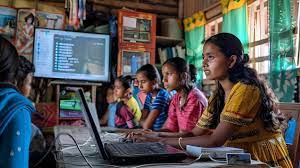In today’s rapidly evolving world, technology is no longer just a tool; it is a catalyst for transformation. In the realm of education, technology is revolutionizing how knowledge is delivered and accessed. The integration of innovative digital tools and platforms has paved the way for a more inclusive and accessible learning experience. In this article, we will explore how technology is bridging educational gaps and providing students with the opportunities they need to thrive in an increasingly digital world.
The Role of Technology in Modern Education
Technology is reshaping education by offering new ways to learn, teach, and engage. The internet, digital devices, educational apps, and learning management systems have created a more dynamic learning environment. These innovations have made it possible to:
- Improve Access to Education: Technology breaks down geographical and financial barriers, making education accessible to students worldwide. Whether it’s remote learning, online courses, or educational resources available at the click of a button, technology ensures that quality education is no longer restricted to traditional classrooms.
- Personalize Learning Experiences: Adaptive learning platforms use data to tailor lessons to the individual needs of each student, allowing for a customized education experience. This not only enhances student engagement but also helps improve learning outcomes.
- Support Diverse Learning Styles: Technology enables educators to use a variety of teaching methods, catering to the diverse learning styles of students. Interactive videos, gamification, virtual reality (VR), and augmented reality (AR) are some of the tools that offer hands-on experiences and facilitate immersive learning.
- Promote Collaboration and Communication: Online collaboration tools, discussion forums, and digital classrooms foster communication between students and teachers, making learning more interactive and collaborative. Students can work together on projects, share ideas, and receive feedback without the constraints of traditional school settings.
- Empower Educators: Educators now have access to a wealth of resources and digital tools that enhance their teaching methods. From lesson planning to assessment and feedback, technology enables teachers to be more efficient and effective, ultimately benefitting students.
Closing the Education Gap with Technology
While technology holds immense promise, it is also crucial to acknowledge the challenges and disparities that still exist in global education systems. Some key challenges include:
- Digital Divide: Many regions, particularly rural areas, lack reliable internet access and technological infrastructure. To bridge this gap, governments and private sectors must work together to ensure equitable access to digital tools.
- Digital Literacy: Not all students and teachers are digitally literate. Investing in training programs and ensuring adequate support for educators and learners will be essential to making technology in education truly effective.
- Data Privacy and Security: As educational systems collect more data to personalize learning experiences, it is crucial to safeguard this information. Schools must adopt secure systems to protect the privacy of students and staff.
Innovative Technologies Shaping Education
Several technologies are currently at the forefront of transforming education:
- Artificial Intelligence (AI): AI is revolutionizing the classroom by providing personalized learning experiences. AI tools can analyze student data, identify learning gaps, and suggest targeted interventions.
- Virtual Reality (VR) and Augmented Reality (AR): These immersive technologies allow students to experience historical events, scientific phenomena, or even distant cultures firsthand, making education more engaging and impactful.
- Gamification: Incorporating game mechanics into education enhances student motivation and learning outcomes. Educational games can make complex subjects more engaging while fostering creativity and critical thinking.
- Learning Management Systems (LMS): Platforms like Moodle, Google Classroom, and Blackboard allow educators to create, share, and manage lessons, track student progress, and facilitate communication with ease.
- Cloud Computing: Cloud-based tools enable students and teachers to access educational content and collaborate remotely. These platforms also support real-time data sharing, improving communication and feedback loops.
The Future of Education
As we continue to explore the potential of technology in education, the future looks promising. Artificial intelligence, machine learning, and virtual reality are expected to be integral parts of the learning landscape, driving innovation and accessibility. Educational systems will likely continue to evolve, emphasizing flexible learning environments, personalized education, and real-time assessment.
Conclusion
Technology has the power to bridge educational gaps, ensuring that all students—regardless of their geographical location, socioeconomic status, or learning style—can access the resources and opportunities they need to succeed. As digital tools and platforms continue to evolve, the future of education holds exciting potential for innovation and inclusivity. By embracing these technologies, we can create a more equitable, engaging, and empowering education system for learners around the world.
SEO Optimized Keywords:
- Innovative education
- Bridging educational gaps
- Technology in education
- Personalized learning
- Digital learning tools
- Learning management systems
- Virtual reality in education
- Online learning platforms
- Education technology
- Gamification in education
- Artificial intelligence in education
- Digital divide in education
- Education for all
- Future of education
- Collaborative learning tools
- Digital literacy in education
- Virtual classrooms
- Technology-enhanced learning
- Online education resources
- Personalized learning experiences

